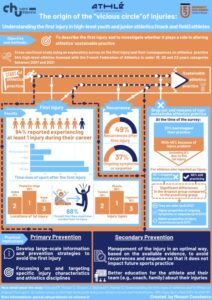Keywords: Injury; epidemiology; injury prevention; injury risk factors; youth; growing.
This blog summarises a recently published study to better understand the primary injury in athletes and investigate if it plays a role in their performance and career (1). The main findings of this study are displayed in the attached infographic and portray the main findings and perspective of this study.

Figure 1: Infographic presenting the study from Edouard et al., 2024 (1)
It is well known that training and competing in athletics (track and field) leads to a risk of injuries (2). Athletic performances can be affected by these injuries, as well as short and long term consequences with health. This can lead to drop out in athletics (3,4). Therefore, reducing injury risk represents a priority to allow both sustainable and healthy athletic practice and the best level of performance.
A history of previous injuries is a frequently reported injury risk factor (2). This study aimed to describe the first injury and investigate whether it plays a role in altering the sustainable practice of athletics (Figure 1) (1). We thus conducted a cross-sectional study using an exploratory survey on the first injury and its consequences on athletics practice, in a population of high-level athletes licensed with the French Federation of Athletics (FFA) under 18 years, under 20 years and under 23 years categories between 2007 and 2021(1).
Among the 6530 emails sent to the eligible population, a total of 544 (8.3%) answers were received and analysed. Almost all athletes (94%) experienced at least one injury from the start of their career confirming that injury is part of the athlete’s life. At the time of the study, about 20% of the participating athletes had dropped out from athletics, with injury accounting for about 50% of all reported dropouts and the first injury for about 10% of all reported causes (1). The characteristics of the first injury were similar to injuries reported in previous studies in athletics athletes.
Developing strategies to avoid the first injury is an important focus. For example, sharing large-scale information and prevention strategies. Given the disparity of injuries according to the athletics disciplines practiced, it seems important to target prevention more specifically. And even if injury occurs, the challenge of secondary prevention is to optimize the management of this first injury and educate the athletes on their pathology to avoid recurrence and/or sequelae, and in turn reduce their impact on athletics and sports activity. It is also interesting to integrate the athlete’s team (e.g., coach, family) in the management of the injury to promote multidisciplinary management and support.
Authors names & Affiliations:
Constance Mosser1, Joris Chapon1, Frédéric Depiesse2, Debbie Palmer3, Pascal Edouard1,4
1 Université Jean Monnet, Lyon 1, Université Savoie Mont-Blanc, Inter-university Laboratory of Human Movement Biology (EA 7424), Saint-Etienne, France
2 CH Chalons en Champagne et Institut Mutualiste de Montsouris, Paris, France
3 Edinburgh Sports Medicine Research Network & UK Collaborating Centre on Injury and Illness Prevention in Sport, Institute for Sport, PE and Health Sciences, The University of Edinburgh, Edinburgh, UK
4 Department of Clinical and Exercise Physiology, Sports Medicine Unit, University Hospital of Saint-Etienne, Faculty of Medicine, Saint-Etienne, France
Correspondence to:
E-mail address: Pascal.Edouard@univ-st-etienne.fr (Pascal EDOUARD)
Pascal Edouard, PU-PH, MD PhD, Department of Clinical and Exercise Physiology, Sports Medicine Unit, IRMIS, Campus Santé Innovations, University Hospital of Saint-Etienne, 42 055 Saint- Etienne cedex 2, France. Tel.: +33 674 574 691; Fax numbers: +33 477 127 229; E-mail: Pascal.Edouard@univ-st-etienne.fr
Funding: There was no funding associated with this study.
Competing Interest: None declared. PE and DP are Associate Editors for the Brit J Sports Med, and PE is an Associate Editor for the BMJ Open Sports and Exercise Medicine.
REFERENCES
1 Edouard P, Mosser C, Chapon J, Depiesse F, Palmer D. Understanding the first injury in athletics and its effect on dropout from sport: An online survey on 544 high-level youth and junior athletics (track and field) athletes. BMJ Open Sport & Exercise. 2024;10:e001767.
2 Edouard P, Alonso JM, Jacobsson J, et al. Injury Prevention in Athletics: The Race Has Started and We Are on Track! New Stud Athl 2015;30:69–78.
3 Palmer D, Cooper DJ, Emery C, et al. Self-reported sports injuries and later-life health status in 3357 retired Olympians from 131 countries: A cross-sectional survey among those competing in the games between London 1948 and PyeongChang 2018. Br J Sports Med 2021;55:46–53.
4 Huxley DJ, O’Connor D, Healey PA. An examination of the training profiles and injuries in elite youth track and field athletes. Eur J Sport Sci 2014;14:185–92.